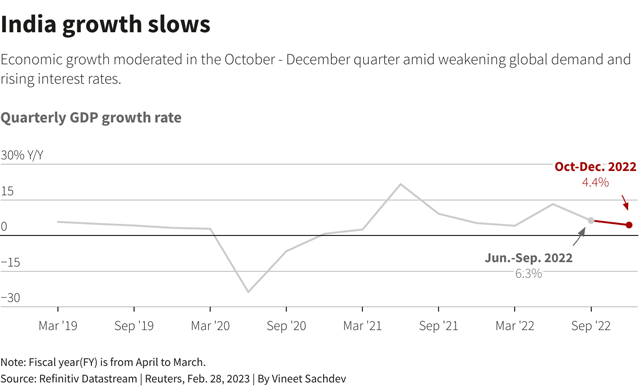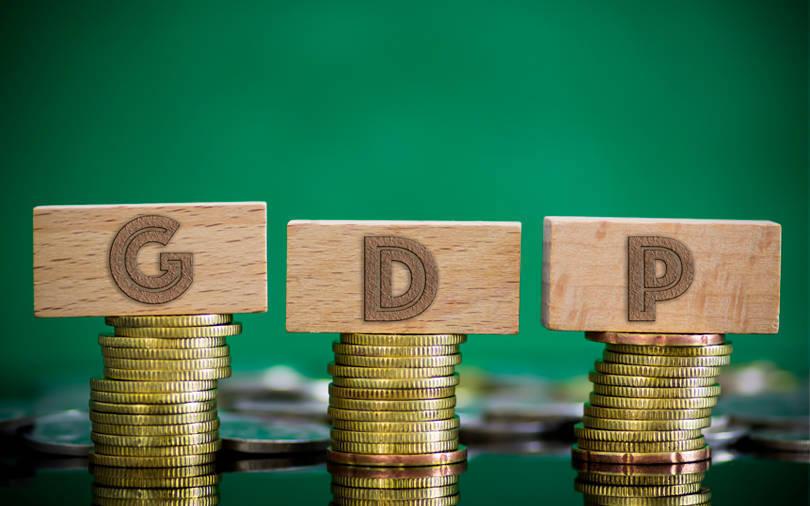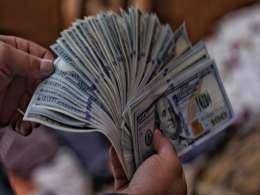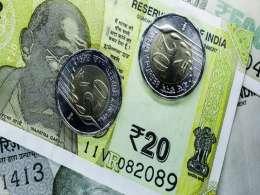India's economic growth slowed further in the December quarter as pent-up demand eased and weakness in the manufacturing sector continued.
Asia's third largest economy recorded year-on-year growth of 4.4% in October-December, down from 6.3% in July-September, data released by the government on Tuesday showed. The sharp fall in the year-on-year growth rate is also partly due to a fading of pandemic-induced base effects and revision to last year's growth, economists said.
October-December growth was below a Reuters forecast of 4.6%.
The government, however, retained its growth forecast of 7% for 2022/23 while revising higher growth for the previous year to 9.1% from the earlier 8.7%.
"We are likely to hit the 7% GDP growth target for the year," said India's chief economic advisor V. Anantha Nageswaran at a press briefing. Growth of 4-4.1% is possible in the January-March quarter, he said.
Even though a weaker global economy is likely to pull down India's growth to near 6.4% next year, the International Monetary Fund (IMF) and the World Bank project India to be the fastest-growing major economy in 2023.

India's manufacturing sector shrank by 1.1% year-on-year in the third quarter, a second straight contraction reflecting lower profit margins and weaker exports.
External demand was weak as central banks globally continued monetary tightening to tame inflation.
"The major disappointment is negative growth in manufacturing," said Madan Sabnavis, economist at state-run Bank of Baroda. He said 2022/23 growth will be at 6.8% against a government estimate of 7%.

The Reserve Bank of India (RBI), has raised its benchmark repo rate by 250 basis points since May last year and economists expect a further rate hike of 25 basis points to 6.75% in April, which could hurt growth in the coming quarters.
India's private consumer spending, contributing around 60% of GDP, rose just 2.1% year-on-year in December quarter, compared to downwardly revised 8.8% increase in the previous quarter, while capital investment rose 8.3% year-on-year compared to revised 9.7% growth in the same period.
Private investment activity is recovering, said Nageswaran.
Government spending declined 0.8% year-on-year in the December quarter compared to revised 4.1% contraction in the previous quarter.
Expenditure Components of GDP https://www.reuters.com/graphics/INDIA-ECONOMY/GDP/gdvzqmmlzpw/chart.png
"There is a significant deceleration in consumption growth - both for the private and government sectors," said Rupa Rege Nitsure, economist at L&T Financial Holdings.
"A possibility of additional interest rate hikes coupled with a slowdown in overall demand pose a further downside risk to manufacturing activity."
Acknowledging the risks from global and local inflation, chief economic advisor Nageswaran said that policymakers need to be ready with supply-side and monetary policy measures to tackle inflation uncertainties.
"Borrowing costs may stay higher for longer and entrenched inflation may prolong tightening cycle globally," he said.
In real terms, India's GDP is estimated at 159.71 trillion rupees ($1.93 trillion) in the current financial year ending in March, about 9.6% higher compared to pre-COVID level of 145.69 trillion rupees ($1.76 trillion) in 2019/20, data showed.






